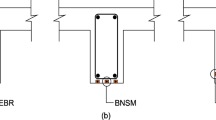Abstract
In steel plate girder railway bridges with open deck system, damage caused by local corrosion of the upper flanges under sleepers is well-known. This damage reduces ultimate strength of the main girders significantly (e.g., in the case of 50%-corroded upper flanges, approximately 30 percent reduction in bending strength). This paper presented a simple evaluation method for estimating the remaining strength of the plate girders that have local corrosion damage under sleepers. Remaining strength of the damaged plate girders can be calculated by taking into account both the remaining strength for local load (hereinafter referred to as “patch load”) that acts directly on the upper flanges under the sleepers, and the remaining strength for bending load that acts on the main beam itself. This new evaluation method using the equations proposed in this paper, is based on the idea that the remaining strength under pure bending load can be obtained as the minimum value of strengths calculated in light of the various buckling modes of the compression flange, while taking the thickness reduction due to corrosion into account. Thereafter, the remaining strength under patch load only can be calculated by using an equation which is further simplified based on Takimoto’s original equation. Finally, the remaining strength of the plate girder as a whole is obtained from the strength interaction curve between patch and bending loads. In addition, by comparing the estimated remaining strengths obtained through this method with those obtained from nonlinear Finite Element Method (FEM) analyses using full-scale beam models, it could be concluded that the simple evaluation method by using both new and original equations can estimate the remaining strength of plate girders with corroded flanges under sleepers with around 95 percent accuracy.
Similar content being viewed by others
References
ABAQUS (2010). “Abaqus/CAE 6.10 user’s manual.” https://www.sharcnet.ca/Software/Abaqus610/Documentation/docs/v6.10/pdf-books/CAE.pdf.
Basler, K. and Thurlimann, B. (1961). “Strength of plate girders in bending.” Proc. of ASCE, ASCE, Vol. 87, No. ST6, pp. 153–181.
Bergfelt, A. (1971). “Studies and tests on slender plate girders without stiffeners shear strength and local web crippling.” International Association for Bridge and Structural Engineering, London, pp. 67–83.
Bergfelt, A. and Hovik, J. (1970). “Shear failure and local web crippling in thin walled plate girders.” Chalmers Univ. of Technology. Inst. Skr., S70:11b.
Cinitha, A., Umesha, P., and Nagesh, R. (2014). “An overview of corrosion and experimental studies on corroded mild steel compression members.” KSCE Journal of Civil Engineering, KSCE, Vol. 18, No. 6, pp. 1735–1744, DOI: 10.1007/s12205-014-0362-0.
Dubas, P. and Gehri, E. (1975). “Behaviour of webs under concentrated loads acting between vertical stiffeners.” European Convention of Constructional Steelworks, Commission 8.3, Zurich.
Fujino, M. (1978). “Experimental study on combined strength of plate girders with initial imperfections.” Journal of JSCE, JSCE, No. 269, pp. 1–15, DOI: 10.2208/jscej1969.1978.1.
Granholm, C.A. (1976). “Light girders. girders with slender flanges and web.” Chalmers Univ. of Technology, Inst. Skr., S76.
Kaita, T., Fujii, K., Miyashita, M., Uenoya, M., and Nakamura, H. (2005). “An experimental study on remaining bending strength of corroded plate girder.” Journal of Structural Engineering, JSCE, Vol. 51A, pp. 139–148.
Komatsu, S., Moriwaki, Y., Fujino, M., and Takimoto, T. (1982). “Ultimate strength of plate girders under combined bending and shear.” Journal of JSCE, JSCE, No. 321, pp. 1–14, DOI: 10.2208/jscej1969.1982.321_1.
Moriwaki, Y. and Fujino, M. (1976). “Experimental study on shear strength of plate girders with initial imperfections.” Journal of JSCE, JSCE, No. 248, pp. 41–54, DOI: 10.2208/jscej1969.1976.249_41.
Moriwaki, Y. and Fujino, M. (1977). “Experimental study on pure bending strength of plate girders with initial imperfections.” Journal of JSCE, JSCE, No. 264, pp. 1–15, DOI: 10.2208/jscej1969.1977.264_1.
Moriwaki, Y., Takimoto, T., and Mimura, Y. (1983). “Ultimate strength of girders under patch loading.” Journal of JSCE, JSCE, No. 339, pp. 69–77, DOI: 10.2208/jscej1969.1983.339_69.
Moriwaki, Y., Takimoto, T., and Yasui, Y. (1988). “An extended calculation method of the ultimate strength of girders under patch loading.” Journal of JSCE, JSCE, No. 392, pp. 281–287, DOI: 10.2208/jscej.1988.392_281.
Nakayama, T., Kondo, T., Ishikawa, T., Shimizu, K., and Matsui, S. (2007). “Study on decrease of load carrying of girder due to corrosion of upper flange under sleeper.” Proc. of JSCE, The 62nd Annual Academic Lecture Meeting, JSCE, I–370.
Nakayama, T., Okamoto, S., Kondo, T., Fujii, K., and Matsui, S. (2010). “Remaining strength of plate girder with local corrosion under railway sleeper in the upper flange.” Journal of Structural Engineering, JSCE, Vol. 56A, pp. 145–156, DOI: 10.11532/structcivil.56A.145.
Nastran (2012). “MSC/Nastran Implicit Nonlinear User’s Manual.”
Rocky, K. C. (1977). “The behaviour of plates when subjected to in-plane patch loading.” Bridge Section, Department of Transport, London.
Skaloud, M. and Novak, P. (1975). “Post-buckled behaviour of webs under partial edge loading.” Acad. Sci. Rep. Prague, No. 3.
Usami, T., Ito, Y., Yamaguchi, E., Oda, H., Goto, Y., Nogami, K., and Sugiura, K. (2005). “Guidelines for stability design of steel structures.” Japan Society of Civil Engineers, JSCE.
Author information
Authors and Affiliations
Corresponding author
Rights and permissions
About this article
Cite this article
Asao, N., Fujii, K. Remaining Strength Estimation Methods of Plate Girders with Corrosion and the Practical Evaluations. KSCE J Civ Eng 23, 228–237 (2019). https://doi.org/10.1007/s12205-018-1513-5
Received:
Revised:
Accepted:
Published:
Issue Date:
DOI: https://doi.org/10.1007/s12205-018-1513-5




